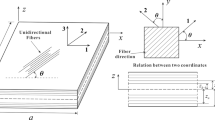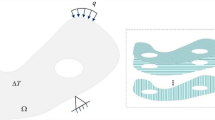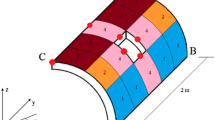Abstract
This paper develops the coordinative optimization method based on system reliability for laminated structures. The proposed method improves the rough RBO based on first layer failure (FLF) criterion for composite laminates, and the coupling optimization method of thickness and sequence in traditional RBO strategy based on last layer failure criterion (LLF) is improved. In this paper, the finite element analysis is used to obtain the response for the failure based on two-dimension Hashin failure criterion (the limit function). Obviously, the stiffness of composite materials will decline due to destruction of elements. Therefore, stiffness degradation is considered to describe the process of damage evolution. Subsequently, combining with the branch-bound method (B&B), we can complete the search of main failure sequences and calculate the system reliability with the help of the second-order upper bound theory. In order to guarantee the efficiency and accuracy of optimization, the adaptive GA algorithm is introduced in the whole optimization procedure. After the proposed optimization policy is given in detail, two laminated structures are presented and the results are compared with the traditional optimal method based on safety factor, which demonstrates the validity and reasonability of the developed methodology.
















Similar content being viewed by others
References
AIAA, System reliability-based optimization of composite structures, Probabilistic Mechanics & Structural Reliability (1996), 1998
António CAC, Marques AT, Gonçalves JF (1996) Reliability based design with a degradation model of laminated composite structures. Struct Optim 12:16–28
Cederbaum G, Elishakoff I, Librescu L (1990) Reliability of laminated plates via the first-order second-moment method. Compos Struct 15:161–167
Chen NZ, Guedes Soares C (2007) Progressive failure analysis for prediction of post-buckling compressive strength of laminated composite plates and stiffened panels. J Reinf Plast Compos 26:1021–1042
Chen S, Lin Z, An H, Huang H, Kong C (2013) Stacking sequence optimization with genetic algorithm using a two-level approximation. Struct Multidiscip Optim 48:795–805
Dolinski K, Dolinski K (1982) First-order second-moment approximation in reliability of structural systems: critical review and alternative approach. Struct Saf 1:211–231
Farshi B, Herasati S (2006) Optimum weight design of fiber composite plates in flexure based on a two level strategy. Compos Struct 73:495–504
Gavin HP, Yau SC (2008) High-order limit state functions in the response surface method for structural reliability analysis. Struct Saf 30:162–179
Hou JW, Gumbert CR, Newman PA (2004) A Most probable point-based method for reliability analysis, Sensitivity Analysis and Design Optimization
Jeong HK, Shenoi RA (2000) Probabilistic strength analysis of rectangular FRP plates using Monte Carlo simulation. Comput Struct 76:219–235
Jianqiao C, Tang Y, Qunli X (2013) Reliability design optimization of composite structures based on PSO together with FEA. Chin J Aeronaut 26:343–349
Kang Z, Luo Y (2009) Non-probabilistic reliability-based topology optimization of geometrically nonlinear structures using convex models. Comput Methods Appl Mech Eng 198:3228–3238
Lee OS, Park YC, Dong HK (2007) Reliability estimation of solder joints under thermal fatigue with varying parameters by using FORM and MCS. J Mech Sci Technol 2166:683–688
Li HS (2013) Reliability-based design optimization via high order response surface method. J Mech Sci Technol 27:1021–1029
Lim J, Lee B (2016) A semi-single-loop method using approximation of most probable point for reliability-based design optimization. Struct Multidiscip Optim 53:745–757
Lin SC, Kam TY (2000) Probabilistic failure analysis of transversely loaded laminated composite plates using first-order second moment method. J Eng Mech 126:812–820
Liu B, Haftka RT, Akgün MA (2000) Two-level composite wing structural optimization using response surfaces, Structural & Multidisciplinary Optimization, 20:87–96
Liu X, Mahadevan S, Liu X, Mahadevan S (2013) System reliability of composite laminates, Structures, Structural Dynamics, and Materials Conference
López C, Bacarreza O, Baldomir A, Hernández S, Aliabadi MHF (2016) Reliability-based design optimization of composite stiffened panels in post-buckling regime. Struct Multidiscip Optim:1–21
Luo Y, Li A, Kang Z (2011) Reliability-based design optimization of adhesive bonded steel–concrete composite beams with probabilistic and non-probabilistic uncertainties. Eng Struct 33:2110–2119
Ma J, Ren Z, Zhao G, Zhang Y, Koh CS (2017) A new reliability analysis method combining adaptive kriging with weight index Monte Carlo simulation, IEEE transactions on magnetics, PP 1–4
Mahadevan S, Liu X, Xiao Q, Probabilistic Progressive A (1997) Failure model of composite laminates. J Reinf Plast Compos 16:1020–1038
Melchers RE, Ahammed M, Middleton C (2003) FORM for discontinuous and truncated probability density functions. Struct Saf 25:305–313
Mitra J, Xu X (2010) Composite system reliability analysis using particle swarm optimization, IEEE International Conference on Probabilistic Methods Applied To Power Systems, pp. 548–552
Nafday AM, Corotis R.B (1987) Failure mode enumeration for system reliability assessment by optimization algorithms, Springer Berlin Heidelberg
Onkar AK, Upadhyay CS, Yadav D (2007) Probabilistic failure of laminated composite plates using the stochastic finite element method. Compos Struct 77:79–91
Park JS, Kim CG, Hong CS (2015) Bimodal bound of system reliability for random composite structures. AIAA J 34:1494–1500
Qiu Z (2003) Comparison of static response of structures using convex models and interval analysis method. Int J Numer Methods Eng 56:1735–1753
Qiu Z, Elishakoff I (1998) Antioptimization of structures with large uncertain-but-non-random parameters via interval analysis. Comput Methods Appl Mech Eng 152:361–372
Qiu Z, Yang D, Elishakoff I (2008) Probabilistic interval reliability of structural systems. International Journal of Solids & Structures 45:2850–2860
Rahman S, Wei D (2006) A univariate approximation at most probable point for higher-order reliability analysis. Int J Solids Struct 43:2820–2839
Rais-Rohani M, Singh MN (2004) Comparison of global and local response surface techniques in reliability-based optimization of composite structures. Struct Multidiscip Optim 26:333–345
Salas P, Venkataraman S (2007) Controlling failure using structural fuses for predictable progressive failure of composite laminates. Struct Multidiscip Optim 34:473–489
Thoft-Christensen P, Murotsu Y (1989) Application of structural system reliability theory. J Am Stat Assoc 84
Todoroki A, Sekishiro M (2007) Two-level optimization of dimensions and stacking sequences for hat-stiffened composite panel. J Comput Sci Technol 1:22–33
Venugopal SM (2003) Stochastic mechanics and reliability of composite laminates based on experimental investigation and stochastic FEM. Mech Ind Eng
Wang X, Guo B (2004) Optimization of laminated composite plates based on the last-ply failure criterion. J Mech Strength
Wang X, Li Z (2009) Reliability-based robust of symmetric laminated plates subject to last-ply failure, International Conference on Industrial Mechatronics and Automation, pp. 464–467
Wang L, Liang J, Wu D (2018) A non-probabilistic reliability-based topology optimization (NRBTO) method of continuum structures with convex uncertainties. Struct Multidiscip Optim:1–20
Zhang X, Chang X (2008) A Probabilistic Progressive Failure model for reliability of composite laminates, 2008 national academic symposium for ph. d. candidates and tri-university workshop on aero-structural mechanics & aerospace engineering
Zhao Y, Su GS, Yan LB (2014) KNN classification based MCS method of structural reliability analysis. Appl Mech Mater 638-640:136–139
Zhu ZQ, Chen JJ, Song ZF, Lin LG (2010) Non-probabilistic reliability index of bar structures with interval parameters based on modified affine arithmetic, Engineering Mechanics, 27:49–54
Acknowledgements
The authors would like to thank the National Key Research and Development Program (No. 2016YFB0200700), the Defense Industrial Technology Development Program (No. JCKY2016601B001, No. JCKY2017601B001) P. R. China (11432002, 11572024, 11872089) and for the financial supports. Besides, the authors wish to express their many thanks to the reviewers for their useful and constructive comments.
Author information
Authors and Affiliations
Corresponding author
Additional information
Responsible Editor: Pingfeng Wang
Publisher’s Note
Springer Nature remains neutral withregard to jurisdictional claims in published mapsand institutional affiliations.
Appendix
Appendix
In order to validate the accuracy of the proposed method for system failure probability of laminates, the numerical approach for system failure probability based upon Monet Carlo simulation is given below.
-
Step1
Initialize the numbers of generated samples and failed samples as Ngenerated = 1e6 \( {N}_T^{fiber} \), \( {N}_C^{fiber} \), \( {N}_T^{matrix} \)and \( {N}_C^{matrix} \), which respectively represents FT failure, FC failure, MT failure and MC failure mode;
-
Step2
Conduct the response analysis by the finite element method. Substitute the data σ1, σ2, τ12 into the four state functions Eq. 1, record sensitivity information of failure modes and restore the failed samples as follow rule:
If the FT mode happens, then \( {N}_T^{fiber}={N}_T^{fiber}+1 \), the FT failure probability is calculated as \( {P}_{FT}=\frac{N_T^{fiber}}{N_{generated}} \); if the FC failure mode happens, then \( {N}_C^{fiber}={N}_C^{fiber}+1 \), the FC failure probability is calculated as \( {P}_{FC}=\frac{N_C^{fiber}}{N_{generated}} \); If the MT mode happens, then \( {N}_T^{matrix}={N}_T^{matrix}+1 \), the MT failure probability is calculated as \( {P}_{MT}=\frac{N_T^{matrix}}{N_{generated}} \); If the MC mode happens, then \( {N}_C^{matrix}={N}_C^{matrix}+1 \), the MC failure probability is calculated as \( {P}_{MC}=\frac{N_C^{matrix}}{N_{generated}} \);
-
Step3
Compare the size of four failure modes and update the stiffness matrix based on the materials degradation criteria, further complete the search of main failure sequences with help of B&B method:
-
(i)
The max failure possibility is obtained Pmax, therefore the maxth layer can be considered as destroyed firstly and the stiffness is deteriorated correspondingly, then go to step 1 and 2 for structural reanalysis;
-
(ii)
Pi stands for each ply failure probability, if the relation Pi/Pmax ≥ 0.3, the i − th layer is record as branching point, which represents the i − th layer can also be destroyed firstly, and then the stiffness is deteriorated correspondingly, then go back to step 1 and 2;
-
(iii)
Above analysis procedure is end until total stiffness matrix becomes singular ∣ det KT/ det K0 ∣ ≤ λ(λ → 0), and the main failure sequences are found.
-
(i)
-
Step4
According with sensitivity information obtained in step 2, calculate the correlation factor by Eq. 13, the failure probability of single main sequence \( {P}_f^{sys} \) is computed, and the system failure probability Pf is acquired with help of the weakest sequence.
Rights and permissions
About this article
Cite this article
Ma, Y., Wang, X., Shi, Q. et al. Coordinative optimization method of composite laminated structures based on system reliability. Struct Multidisc Optim 59, 1483–1501 (2019). https://doi.org/10.1007/s00158-018-2141-x
Received:
Revised:
Accepted:
Published:
Issue Date:
DOI: https://doi.org/10.1007/s00158-018-2141-x




